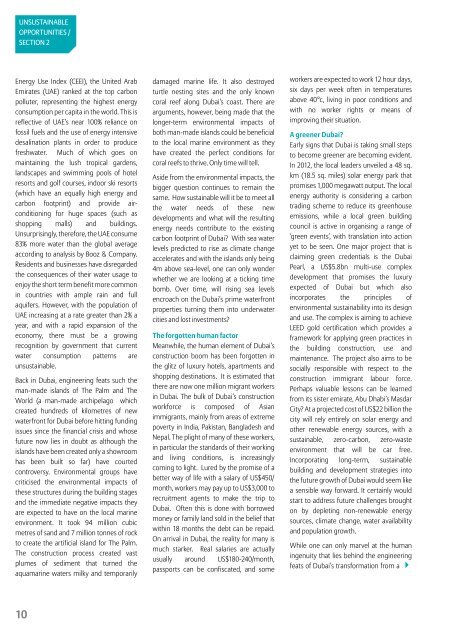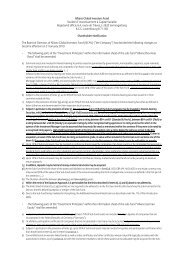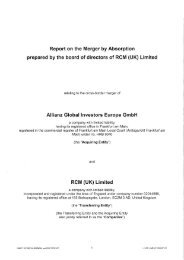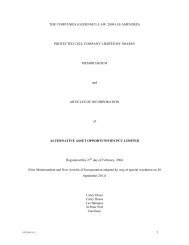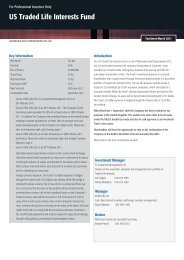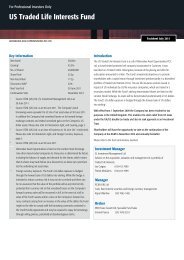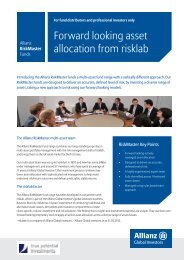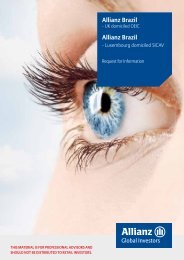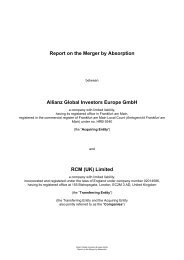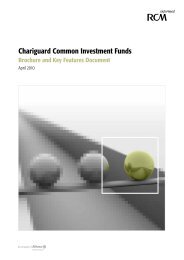ESG Matters, Issue 5, April 2013 - Allianz Global Investors
ESG Matters, Issue 5, April 2013 - Allianz Global Investors
ESG Matters, Issue 5, April 2013 - Allianz Global Investors
You also want an ePaper? Increase the reach of your titles
YUMPU automatically turns print PDFs into web optimized ePapers that Google loves.
Unsustainableopportunities /section 2Energy Use Index (CEEI), the United ArabEmirates (UAE) ranked at the top carbonpolluter, representing the highest energyconsumption per capita in the world. This isreflective of UAE’s near 100% reliance onfossil fuels and the use of energy intensivedesalination plants in order to producefreshwater. Much of which goes onmaintaining the lush tropical gardens,landscapes and swimming pools of hotelresorts and golf courses, indoor ski resorts(which have an equally high energy andcarbon footprint) and provide airconditioningfor huge spaces (such asshopping malls) and buildings.Unsurprisingly, therefore, the UAE consume83% more water than the global averageaccording to analysis by Booz & Company.Residents and businesses have disregardedthe consequences of their water usage toenjoy the short term benefit more commonin countries with ample rain and fullaquifers. However, with the population ofUAE increasing at a rate greater than 2% ayear, and with a rapid expansion of theeconomy, there must be a growingrecognition by government that currentwater consumption patterns areunsustainable.Back in Dubai, engineering feats such theman-made islands of The Palm and TheWorld (a man-made archipelago whichcreated hundreds of kilometres of newwaterfront for Dubai before hitting fundingissues since the financial crisis and whosefuture now lies in doubt as although theislands have been created only a showroomhas been built so far) have courtedcontroversy. Environmental groups havecriticised the environmental impacts ofthese structures during the building stagesand the immediate negative impacts theyare expected to have on the local marineenvironment. It took 94 million cubicmetres of sand and 7 million tonnes of rockto create the artificial island for The Palm.The construction process created vastplumes of sediment that turned theaquamarine waters milky and temporarilydamaged marine life. It also destroyedturtle nesting sites and the only knowncoral reef along Dubai’s coast. There arearguments, however, being made that thelonger-term environmental impacts ofboth man-made islands could be beneficialto the local marine environment as theyhave created the perfect conditions forcoral reefs to thrive. Only time will tell.Aside from the environmental impacts, thebigger question continues to remain thesame. How sustainable will it be to meet allthe water needs of these newdevelopments and what will the resultingenergy needs contribute to the existingcarbon footprint of Dubai? With sea waterlevels predicted to rise as climate changeaccelerates and with the islands only being4m above sea-level, one can only wonderwhether we are looking at a ticking timebomb. Over time, will rising sea levelsencroach on the Dubai’s prime waterfrontproperties turning them into underwatercities and lost investments?The forgotten human factorMeanwhile, the human element of Dubai’sconstruction boom has been forgotten inthe glitz of luxury hotels, apartments andshopping destinations. It is estimated thatthere are now one million migrant workersin Dubai. The bulk of Dubai’s constructionworkforce is composed of Asianimmigrants, mainly from areas of extremepoverty in India, Pakistan, Bangladesh andNepal. The plight of many of these workers,in particular the standards of their workingand living conditions, is increasinglycoming to light. Lured by the promise of abetter way of life with a salary of US$450/month, workers may pay up to US$3,000 torecruitment agents to make the trip toDubai. Often this is done with borrowedmoney or family land sold in the belief thatwithin 18 months the debt can be repaid.On arrival in Dubai, the reality for many ismuch starker. Real salaries are actuallyusually around US$180-240/month,passports can be confiscated, and someworkers are expected to work 12 hour days,six days per week often in temperaturesabove 40°c, living in poor conditions andwith no worker rights or means ofimproving their situation.A greener Dubai?Early signs that Dubai is taking small stepsto become greener are becoming evident.In 2012, the local leaders unveiled a 48 sq.km (18.5 sq. miles) solar energy park thatpromises 1,000 megawatt output. The localenergy authority is considering a carbontrading scheme to reduce its greenhouseemissions, while a local green buildingcouncil is active in organising a range of‘green events’, with translation into actionyet to be seen. One major project that isclaiming green credentials is the DubaiPearl, a US$5.8bn multi-use complexdevelopment that promises the luxuryexpected of Dubai but which alsoincorporates the principles ofenvironmental sustainability into its designand use. The complex is aiming to achieveLEED gold certification which provides aframework for applying green practices inthe building construction, use andmaintenance. The project also aims to besocially responsible with respect to theconstruction immigrant labour force.Perhaps valuable lessons can be learnedfrom its sister emirate, Abu Dhabi’s MasdarCity? At a projected cost of US$22 billion thecity will rely entirely on solar energy andother renewable energy sources, with asustainable, zero-carbon, zero-wasteenvironment that will be car free.Incorporating long-term, sustainablebuilding and development strategies intothe future growth of Dubai would seem likea sensible way forward. It certainly wouldstart to address future challenges broughton by depleting non-renewable energysources, climate change, water availabilityand population growth.While one can only marvel at the humaningenuity that lies behind the engineeringfeats of Dubai’s transformation from a 10


